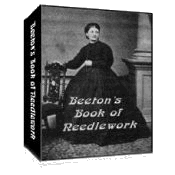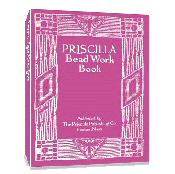[]Subscribe To This Site
Drawn Thread Work

Click on picture to see more detail.
In drawn thread work, perhaps the most useful as well as the simplest, and really the first step to be taken, is the single hem-stitch. It is used for handkerchiefs, scarfs, doilies, etc., and is rapidly executed. At twice the distance from the edge that you wish the width of hem, allowing for turning in the hem, draw 3, 4, 5, or 6 threads, according to fineness of the fabric on which you are working. Turn the hem neatly and baste down to the outer edge of the line thus drawn; insert the needle in the edge of hem, take a cluster of 3, 4, or more threads to the left, draw together, insert needle in edge of fold, and repeat.
The double hem-stitch is begun as single hem-stitch. When making the 2d row of stitches, simply alternate with the 1st, drawing half the threads of one cluster and half the next together.

A very pretty and simple design is shown by Fig. 3. A very handsome scarf to make in Java canvas would be in a rich ecru color, and the drawn work was done with one shade of crochet silk with a cross-stitch pattern above in the same shades plus another one similar to it. Draw 6 threads for edge stripes and 8 for center stripes, and make 6 rows of hem-stitching, taking up 4 threads — this on the canvas. For the center stripe, divide the clusters, insert needle from left to right, under half of the 2nd cluster, turn the needle left to right and take up the 2nd half of the 1st cluster, drawing it under and in front of the 1st half of the 2nd cluster. The engraving will make this plainer than a description can do.

Click on picture to see more detail.
Another insertion rather more elaborate and very handsome is shown by Fig.4. In this the two shades of silk (or any desired colors) are employed, and it would be especially desirable for the scarf referred to. Draw about 30 threads; work the outside figures over 6 clusters of 3 threads each. The middle figure combines the 2,d half of right figure and the 1st half of left figure above and below, and is done in simple weaving stitch.

Click on picture to see more detail.
Fig. 5 shows still another insertion. Draw 5 threads for the narrow stripe and 15 for the wide one. Each cluster is of 4 threads, and the hem-stitching is carried across the narrow band in a cross-stitch. In the wide stripe, knot each cluster of 4 together halfway from edge to center, and connect 4 clusters in the center. Make a wheel by weaving around the threads where crossed.

Click on picture to see more detail.
To turn a corner, the threads must be cut as shown by Fig. 6. These threads, if the hem is not completed, may be pushed under the turn (Fig. 7), or may be turned over on the wrong side and caught (Fig. 8), the buttonholing being then continued around the comer. Fig. 9 shows a completed comer, which, as is the case with drawn work in general, needs no description.

Click on picture to see more detail.

Click on picture to see more detail.
Return to top of Drawn Thread Work page.
Return to Types of Embroidery page.
Return to Home page.



 433 pages!
433 pages!

